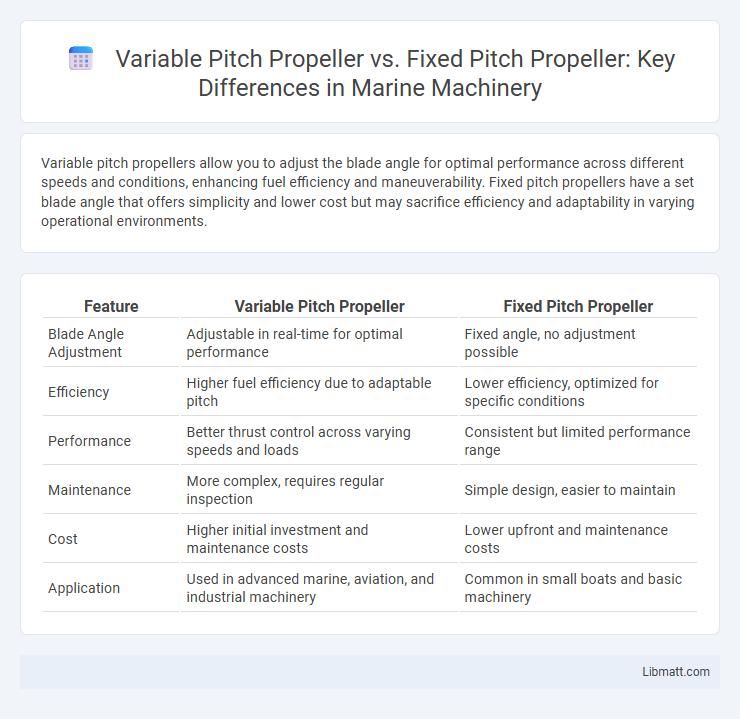Variable pitch propellers allow you to adjust the blade angle for optimal performance across different speeds and conditions, enhancing fuel efficiency and maneuverability. Fixed pitch propellers have a set blade angle that offers simplicity and lower cost but may sacrifice efficiency and adaptability in varying operational environments.
Table of Comparison
| Feature | Variable Pitch Propeller | Fixed Pitch Propeller |
|---|---|---|
| Blade Angle Adjustment | Adjustable in real-time for optimal performance | Fixed angle, no adjustment possible |
| Efficiency | Higher fuel efficiency due to adaptable pitch | Lower efficiency, optimized for specific conditions |
| Performance | Better thrust control across varying speeds and loads | Consistent but limited performance range |
| Maintenance | More complex, requires regular inspection | Simple design, easier to maintain |
| Cost | Higher initial investment and maintenance costs | Lower upfront and maintenance costs |
| Application | Used in advanced marine, aviation, and industrial machinery | Common in small boats and basic machinery |
Introduction to Propeller Types
Variable pitch propellers feature adjustable blade angles that optimize performance and fuel efficiency across different speeds and conditions, often used in complex aviation or marine applications. Fixed pitch propellers have blades set at a single angle, offering simplicity, lower maintenance, and cost-effectiveness ideal for small aircraft and basic boats. The choice between variable pitch and fixed pitch propellers depends on performance requirements, operational flexibility, and budget considerations.
What is a Variable Pitch Propeller?
A variable pitch propeller features adjustable blade angles that allow you to optimize performance for different operating conditions, enhancing fuel efficiency and maneuverability. Unlike fixed pitch propellers with a single blade angle, variable pitch designs adjust to provide better thrust control and improved engine efficiency. This adaptability makes variable pitch propellers ideal for vessels requiring precise speed and power management.
What is a Fixed Pitch Propeller?
A fixed pitch propeller features blades set at a constant angle, optimized for specific operating conditions to ensure simplicity and reliability. It offers efficient performance at a designated speed and power setting but lacks adaptability to varying flight phases or engine loads. This propeller type is commonly used in light aircraft where cost-effectiveness and low maintenance are priorities.
Key Differences Between Variable and Fixed Pitch
Variable pitch propellers allow you to adjust the blade angle for optimal performance across different speeds and conditions, enhancing fuel efficiency and maneuverability. Fixed pitch propellers have a set blade angle, offering simplicity, durability, and lower initial cost but less adaptability to varying operating environments. The key differences lie in operational flexibility, efficiency, and maintenance requirements, with variable pitch providing superior control and fixed pitch excelling in reliability and cost-effectiveness.
Performance Comparison
Variable pitch propellers offer superior performance by allowing real-time blade angle adjustments, optimizing thrust and fuel efficiency across varying speeds and load conditions. Fixed pitch propellers provide consistent output but may underperform at non-optimal RPMs, limiting acceleration and fuel economy. Choosing a variable pitch propeller enhances Your vessel's adaptability, maximizing power and efficiency in diverse operating environments.
Efficiency and Fuel Consumption
Variable pitch propellers offer greater efficiency by allowing blade angles to adjust according to engine speed and load, optimizing thrust and reducing fuel consumption during varying operating conditions. Fixed pitch propellers, while simpler and more durable, maintain a constant blade angle that limits efficiency to a narrower range of speeds, often resulting in higher fuel consumption when operating outside their optimal parameters. Your fuel economy improves significantly with variable pitch propellers, especially during long-distance or variable-speed marine or aviation applications.
Maintenance and Durability
Variable pitch propellers require more frequent maintenance due to their complex mechanisms, including pitch control systems and hydraulic or electric actuators, increasing long-term upkeep costs. Fixed pitch propellers offer greater durability with fewer moving parts, resulting in lower maintenance needs and higher reliability in harsh operating conditions. Your choice depends on balancing the benefits of adjustable performance against maintenance demands and lifespan expectations.
Cost Considerations
Variable pitch propellers generally involve higher initial costs due to their complex mechanism and increased manufacturing precision, making them more expensive than fixed pitch propellers. Maintenance expenses for variable pitch systems can also be significant, as the adjustable blades require regular inspection and occasional servicing to ensure optimal performance and reliability. Fixed pitch propellers offer a cost-effective solution with lower upfront investment and reduced ongoing maintenance requirements, making them preferable for budget-conscious operators.
Typical Applications and Use Cases
Variable pitch propellers are commonly used in aircraft, marine vessels, and industrial applications where performance efficiency and adaptability to changing conditions are critical, such as in commercial aviation, racing boats, and large ships. Fixed pitch propellers are typically found in smaller, less complex vehicles such as recreational boats, light aircraft, and drones, where cost-effectiveness and simplicity are prioritized. The ability of variable pitch propellers to adjust blade angles allows for optimized thrust and fuel efficiency across different speeds and loads, contrasting with fixed pitch propellers which offer fixed performance optimized for specific operating conditions.
Choosing the Right Propeller for Your Needs
Choosing the right propeller depends on the specific boating activities and performance requirements. Variable pitch propellers offer adjustable blade angles, providing enhanced efficiency and better fuel economy across different speeds and conditions. Fixed pitch propellers, with their simpler design and lower cost, deliver reliable performance ideal for consistent speed and straightforward navigation.
Variable pitch propeller vs fixed pitch propeller Infographic

 libmatt.com
libmatt.com